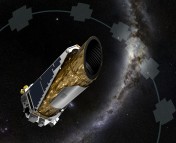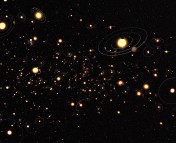Citizen Science
In the summer of 2007, before I decided on a career in astronomy, I had a very boring internship at an engineering company. My boss quit two weeks into my summer, and I was left on the payroll with essentially nothing to do! In my desperation to feel productive, I stumbled across Galaxy Zoo, a citizen science project to categorize galaxies in Hubble data, and I proceeded to categorize hundreds of galaxies that summer.
As it turns out, with minimal training, humans are actually significantly more adept at pattern-recognition tasks such as galaxy categorization than computer algorithms. Citizen Science projects combine this innate human ability with the power of the internet to connect people together, outsourcing thousands of CPU hours to thousands of human brains. The ten current projects on http://www.zooniverse.org/ include Ice Hunters (looking for Kuiper Belt Objects), Moon Zoo (examining data from the Lunar Reconnaissance Orbiter), and non-astronomical projects like Ancient Lives (deciphering ancient texts!).
Planet Hunters
Planet Hunters is one of these Citizen Science projects, aiming to analyze the slew of data from the Kepler Space Telescope. Planet Hunters look for transit signals in the data, which cause the light from the star to dim periodically. Of course, the Kepler Team is also working hard using computer algorithms to analyze the same data; this project is designed to complement those efforts. This paper presents results of the first two planet candidates to be identified using this method, demonstrating that this type of citizen science project is a valuable tool for exoplanet detection.

This figure is a screen shot from the Planet Hunters website. The user marks transits by dragging a box around them.
This project sounds like a really interesting idea, but how do these astronomers actually splice together all the work of citizen scientists behind the scenes? First, they established the detection efficiency of the human pipeline by inserting known planetary candidates into the lists of transit events being analyzed. They find that two-thirds of the total number of known planetary transits were marked and only 10% of the transit marks did not correspond to a transit event.
Once a given transit was found by 5 people, the authors went through a process to validate that it was a transit signal. They began by visually inspecting the transit flags and eliminating known false positives such as eclipsing binary stars. They then ran a series of other standard tests to rule out false positives. At this point, they had narrowed the ~3500 transits found by the citizen scientists to the 10 most likely to be planets. They sent these along to the rest of the Kepler Team.
The Kepler Team has an extensive data verification pipeline and immediately noticed that 6 of the 10 were not quite the right shape for a planetary transit and were likely eclipsing binary stars. Of the remaining 4, upon further investigation, one is probably another false positive, and the other is a multi-candidate system that is still being verified.
The two candidates left have the catchy names KIC 10905746 and KIC 6185331, and they have planet candidates of 2.32 and 8.0 Earth radii, respectively. These are new objects that were not found in the normal Kepler pipeline!

This is the transit light curve from one of the two detected planetary candidates in this paper. The top curve shows light curve in days (about a month and a half of data) and the bottom curve shows the light curve after removing the variability and phase-folding it at the measured period. Note that the Planet Hunters could find this shallow transit despite the stellar variability!
Why is this so interesting?
This project is important and interesting for several reasons. First and foremost, engaging the public — from retired stockbrokers to school children to bored college-age interns — is crucial for the future of astronomical research. And judging from the dozens of blog and news articles published last week, everyone gets very excited about the possibility of “people like you” finding new planets! [Though astronomers are people like you too. I promise!]
Secondly, data analysis pipelines of all kinds have intrinsic biases; since Kepler is largely a statistical mission, we must understand these biases very well in order to understand the statistics of the underlying planet population. For a simple example of the problem, since big planets are easier to find than small planets, the first planets discovered were all giant planets; this of course doesn’t mean that all planets are giant planets, but shows us that our observations have systematic limitations that affect the planets we find. By using complementary methods to analyze the same Kepler dataset— with very different intrinsic systematic biases — we’ll be able to quantify the biases of both pipelines more effectively.





Trackbacks/Pingbacks